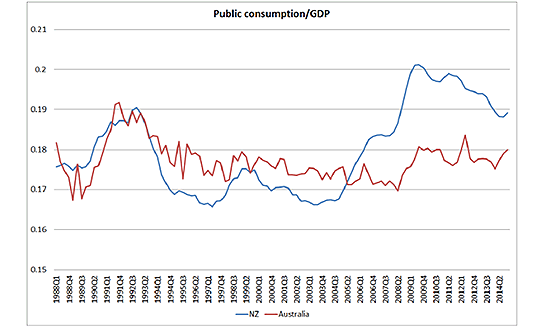
By Eric Crampton*
 Sometimes, it takes a Labour leader to point out the deadweight costs of taxation.
Sometimes, it takes a Labour leader to point out the deadweight costs of taxation.
And so there is a lot to like in Andrew Little’s economic policy statement.
Little highlighted that ACC levies beyond those needed to ensure the scheme’s continued viability come at a substantial economic cost.
ACC charges employers and employees, on average across different industries, $2.16 per $100 in earnings.
ACC had recommended dropping the levies to $1.95 per $100 in earnings.
Economics consultancy Infometrics, commissioned by Labour, estimated that only $1.83 per $100 were really needed to ensure that the ACC scheme were fully funded for the ongoing costs of worker injuries.
If Infometrics’ figures are right, ACC is charging then about $0.33 per $100 more than is necessary.
Infometrics put the economic cost of this extra 0.33% payroll tax – the cost over and above the value of the $350 million or so in excess revenues collected and invested by ACC – at about $70 million dollars or 590 full-time equivalent jobs.
Andrew Little is right to be worried about the deadweight costs of this tax. The extra 0.33 percent that workers and firms pay in ACC levies would be better left in employer and employee pockets.
The Infometrics analysis uses standard Treasury methods where raising a dollar in tax is assumed to cost the country $0.20 over and above the value of the raised dollar: $0.20 in ‘deadweight’ costs, as economists put it. These are not primarily the administrative costs of collecting taxes but rather the costs the economy faces when a payroll tax makes employees more expensive for employers and makes employment less rewarding for employees.
An extra 0.33% in payroll tax will not be a make-or-break issue for most employees or employers, but would be enough to kill just under 600 jobs in a country with just under 2.4 million employed persons. As Little warns, excess taxation by ACC “costs jobs and growth and holds New Zealand back.”
The estimates of the extra burden taxes impose on the economy are most applicable around small changes in tax, like the 0.33% charged by ACC. A larger tax hike would have more than proportionately higher associated expected deadweight costs. A decade ago, Professor John Creedy summarised economists’ rule of thumb on the issue: if the tax rate doubles, the deadweight cost of taxation quadruples.
So the deadweight costs of a 38 or 39 percent top marginal tax rate are much higher than those of a 33 percent top marginal tax rate. That does not necessarily mean that any future Labour government should not raise the top marginal tax rate. But it does mean that the programmes that would be funded at higher tax rates have to pass a higher benefit hurdle – and especially where government consumption spending, as a fraction of GDP, is now no lower than it was at the height of the last Labour government.

Source: Michael Reddell
Little’s economic policy statement, on balance, deserves praise – though many details remain to be worked out. I particularly worry about efforts to “move our production up the value chain” as top-down approaches to achieving that can often prove value-destroying.
But while we are considering changes to ACC to avoid the 0.33 percent excess tax, we could perhaps consider more ambitious changes. In particular, does New Zealand really need strongly prescriptive workplace safety rules if ACC premiums are set correctly? ACC offers reasonable discounts and penalty rates based on firms’ claims histories, with additional discounts for complying with best practice standards in safety.
The New Zealand Initiative’s Dr Bryce Wilkinson provided back-of-the-envelope indicative calculations that the additional costs of more stringent scaffolding regulations alone could be of the order of $180 million. If ACC has its levies set correctly, construction companies (and others) would already have strong incentive to provide a safe work environment, and could tailor their safety practices to reduce accidents by whatever method is most cost-effective in their particular situations rather than having to comply with standards that might not always be fit for purpose.
If Little could ensure that ACC gets its pricing right, and uses that mechanism to help ensure worker safety rather than prescriptive standards, the benefits to the economy could be much greater than the savings from reducing the average ACC levy from 2.16 percent to 1.83 percent.
----------------------------
*Eric Crampton is head of research at The New Zealand Initiative.
1 Comments
Indeed. Worked example.
The insanity of the working-at-heights regs mean, quite simply, that the backyard, under-the-radar methods proliferate. The scaff for a 100-square-metre job on a two-storey house exceeds the paint plus labour cost by a substantial margin.
Workings:
2 coats, at a low 10sq m/l rate = 20 litres of paint, say $400.
Labour - 6 hours at $75/hour including all overheads (truck roll, consumables etc) = $450.
Scaff quote: $2,500 - 80 lineal metres, safety ladders, rails, sub-scaff onto sloping tile roof. Set-up and take-down - one full day each.
Guess how this, and countless other analagous jobs, actually proceed.
In and out under a day, painted/rolled from a long segmented/bendy extension ladder.

We welcome your comments below. If you are not already registered, please register to comment
Remember we welcome robust, respectful and insightful debate. We don't welcome abusive or defamatory comments and will de-register those repeatedly making such comments. Our current comment policy is here.